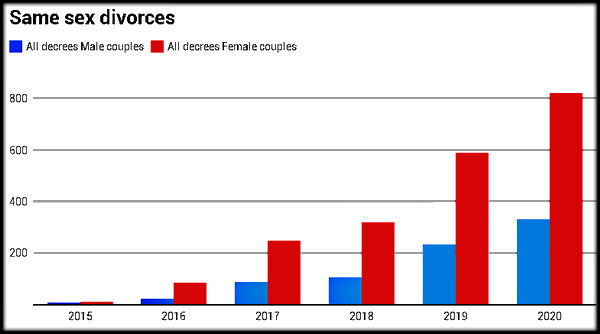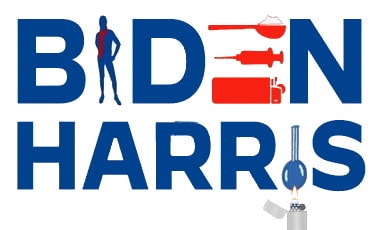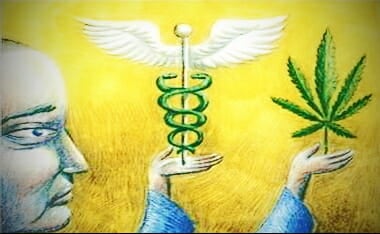Three recent stats regarding homosexual divorce:
-
- LGBTQ+divorce rates have increased by 20% in the past decade.
- Same-sex couples are 1.5 times more likely to divorce than opposite-sex couples.
- The average duration of a same-sex marriage before divorce is 4 years.
In this video, take note that out of homosexual marriages/divorce statistics, 72% of divorces [again, in the gay community] were by lesbians.
(The stats used in the very short clip did not do justice to the real set of statistics and whom they apply to. A proper dealing with them can be found in last video of this post [JUMP]):
In two excellent posts and pulling together some excerpts regarding the stats of the topic is via THE WENTWORTH REPORT:
…Domestic violence in lesbian relationships, by Wikipedia.
The [US] Centers for Disease Control and Prevention’s 2010 National Intimate Partner and Sexual Violence Survey reports on the lifetime prevalence of rape, physical violence or stalking by an intimate partner, focusing for the first time on victimization by sexual orientation. It finds a victimization prevalence of 43.8 percent for lesbians, making it the second most affected group after bisexual women (61.1 percent), ahead of bisexual men (37.3 percent), heterosexual women (35 percent), heterosexual men (29 percent) and homosexual men (26 percent) …
The fear of reinforcing negative stereotypes has led some community members, activists, and victims to deny the extent of violence among lesbians. Social service agencies are often unwilling to assist lesbian victims of domestic violence. Victims of domestic violence in lesbian relationships are less likely to have the case prosecuted within a legal system.
Domestic violence a ‘silent epidemic’ in gay relationships, by Belinda Kontominas. There is even acknowledgement even in the PC press, in this case the Sydney Morning Herald, though it seems to be mainly just anecdotes, of which none are of women using violence.
Domestic violence has become a “silent epidemic” in the gay and lesbian community despite being the subject of increasing scrutiny in heterosexual relationships, according to the AIDS Council of NSW.
Roughly one in three lesbian, gay bisexual, transgender, and intersex (LGBTI) couples experience domestic violence. …
Within the LGBTI community abuse is more frequently reported by women and transgender males than by gay men but Parkhill says more research is needed to determine the full extent of the problem.
2 Studies That Prove Domestic Violence Is an LGBT Issue, by JD Glass.
The National Violence Against Women survey found that 21.5 percent of men and 35.4 percent of women living with a same-sex partner experienced intimate-partner physical violence in their lifetimes, compared with 7.1 percent and 20.4 percent for men and women, respectively, with a history of only opposite-sex cohabitation. Transgender respondents had an incidence of 34.6 percent over a lifetime according to a Massachusetts survey. …
These studies refute the myths that only straight women get battered, that men are never victims, and that women never batter …
“Abuse is not about violence; it’s about control,” says Beth Leventhal, executive director of The Network/La Red in Boston. “You can be just as controlling of someone if you are small — as if you’re large. It’s about using violence or any other means of gaining and maintaining control.”
In an update to the above THE WENTWORTH REPORT brings the topic up to date (2023):
Rate of Domestic Violence Highest in Lesbian Relationships. It’s a PC myth that domestic violence is all about men hurting women in heterosexual relationships. It’s not. Women dish out a lot of violence too, including against kids. Despite convincing studies for decades now, this still seems to surprise people — once again demonstrating the willingness and power of the media to propagate a PC agenda. Keep an eye out for how the domestic violence meme is used — such as to put down straight men.
Lesbian domestic violence proves it’s not just a male problem. By Augusto Zimmermann.
As the studies of lesbian violence demonstrate, women are capable of being as violent as men in intimate relationships. Violence among same-sex couples is apparently two to three times more common than among married heterosexual couples. …
That violence comes out more frequently in lesbian relationships both as resistance and as aggression should put aside our preconceptions of gender socialization and roles. …
Compelling stats:
For example, about a decade ago the US Centers for Disease Control and Prevention’s National Intimate Partner and Sexual Violence Survey reported on the lifetime prevalence of rape, physical violence, or stalking by an intimate partner, focusing for the first time on victimization by sexual orientation.
It found a victimization prevalence of 43.8 per cent for lesbians, making it the second most affected group after bisexual women (61.1 per cent), ahead of bisexual men (37.3 per cent), heterosexual women (35 per cent), heterosexual men (29 per cent) and homosexual men (26 per cent). …
It’s been known for decades:
Erin Pizzey set up the first refuge for battered women, in 1971. Her own experience is that women are just as capable of intimate partner abuse, in both the physical and emotional sense, as men. When she opened her refuge for battered women, 62 of the first 100 women to come through the door were as abusive as the men they had left. And when the feminists started demonizing fathers in the early 1970s, she felt morally obliged to state:
-
- ‘Women and men are both capable of extraordinary cruelty. … We must stop demonizing men and start healing the rift that feminism has created between men and women. This insidious and manipulative philosophy that women are always victims and men always oppressors can only continue this unspeakable cycle of violence. And it’s our children who will suffer.’ …
BERNARD RILEY notes these issues as well in his YouTube upload titled “Lesbian Divorce Rate Higher Than All Others | Women Don’t Like Women Either.”
THE SPECTATOR helps us visually:
- By 2020, 2,900 same-sex couples, of whom nearly three-quarters were female, had divorced. The same trend can be seen in the Netherlands, the first country to allow same-sex marriage: in the ten years from 2005, 15 per cent of gay civil partnerships failed, compared with 30 per cent of lesbian ones. The latest research showed that overall, women are much more likely to instigate divorce proceedings than men, with two-thirds of divorces initiated by women in the past ten years.
Other issues in the homosexual lifestyle is one of drug and alcohol abuse. Substance misuse is a significant problem among members of the LGBTQ+ community.
LGB adults are more than twice as likely as heterosexual adults to experience a mental health condition. Transgender individuals are nearly four times as likely as cisgender individuals (people whose gender identity corresponds with their birth sex) individuals to experience a mental health condition.
LGB youth also experience greater risk for mental health conditions and suicidality. LGB youth are more than twice as likely to report experiencing persistent feelings of sadness or hopelessness than their heterosexual peers. Transgender youth face further disparities as they are twice as likely to experience depressive symptoms, seriously consider suicide, and attempt suicide compared to cisgender lesbian, gay, bisexual, queer and questioning youth.
(NAMI)
Of course the politically correct reasons are offered as to why. Stigma, support, etc. OR, maybe there is a mental health issue underlying the lifestyle to varying degrees. These gay men and women need Jesus just like everyone else on the planet.
This video looks at the statistics more properly.
The Real Reason 70% of Divorces are Initiated by Women







